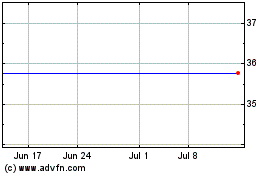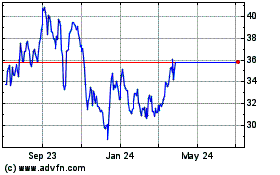By Bradley Olson and Lynn Cook
American shale drillers, which defied expectations and upended
traditional oil markets by increasing production in the face of
lower prices, are finally showing signs of slowing down.
U.S. oil output remains robust and may still surpass the record
annual average of 9.6 million barrels a day, set in 1970. But
companies, confronting technological, operational and financial
obstacles, are starting to tap the brakes on drilling.
The pace of innovation that allowed shale drillers to maintain
production even as prices fell appears to be slowing, experts say.
The cost of labor and services, meanwhile, is rising in the most
popular oil fields, driving up drilling expenses. And companies are
facing a backlash from investors, who have grown weary of drillers
focusing on growth over profit and are insisting they live within
their means.
Future oil production is notoriously difficult to predict, and a
surge in prices could certainly improve the economics of American
shale. But a growing chorus of oil industry leaders, including some
shale trailblazers, believes U.S. growth may peak sooner than
government forecasters have anticipated -- a development with
ramifications for global oil markets.
In recent years, shale production has reliably filled any voids
in world supply, effectively taming volatile price gyrations.
Potential limits to shale growth call into question predictions
that this trend will continue in the future.
"There are no new shale plays that have come forward," said Mark
Papa, chief executive of Centennial Resource Development Inc. and
former CEO of EOG Resources Inc. "Their ability to spew forth
infinite streams of oil is really just a myth."
The U.S. oil rig count, typically viewed as a proxy for activity
in the sector, grew 6% in the third quarter -- a marked
deceleration from the previous four quarters, when it rose more
than 20% on average.
American oil production has averaged roughly 9.16 million
barrels a day so far this year, according to data from the U.S.
Energy Information Administration. Last month, the EIA cut its
forecast for U.S. oil production, saying it now expects the
industry to end the year at 9.69 million barrels a day, down from
9.82 million.
That revised estimate is still too high, according to Harold
Hamm, CEO of Continental Resources Inc. "The EIA's phantom forecast
needs huge growth to catch up to projections," said Mr. Hamm, one
of the pioneers of North Dakota's Bakken Shale formation.
An EIA spokesman defended the agency's forecasts and said it
continues to see month-on-month increases in U.S. production,
particularly in the Permian basin.
Oil prices, which plunged from highs of over $100 in 2014,
bounced back in September to over $50 a barrel. Still, chief
executives of three major U.S. producers said last month they
wouldn't necessarily spend more on drilling even if prices rise to
$60 a barrel.
Pioneer Natural Resources Co. CEO Tim Dove said at a conference
in Oklahoma City that a "thundering herd" of investors has asked
the company to focus on returns, not growth.
The company stunned shareholders in August when Mr. Dove said
some recently drilled wells in the Permian basin -- a region in
Texas and New Mexico that has become the hottest drilling spot in
the world -- were a "train wreck." Underground pressure problems
stymied output and delayed drilling for months, he said.
The company says the problem has been solved, but the solution
added about $400,000 to the cost of each well. Now, Pioneer is
having to chip away elsewhere to make up the difference.
Delays for fracking and related services are also becoming
problematic for producers. Permian producers Parsley Energy, Callon
Petroleum Co. and QEP Resources Inc. recently reduced production
estimates, citing delayed fracking services and other
challenges.
Many new Permian wells are producing more oil and gas than they
did a year ago, largely due to techniques such as drilling longer
wells and injecting more sand into fractured rock to allow more oil
and gas to flow out. But if that production is measured based on
the length of a well, or barrels pumped per foot of well length, it
appears operators aren't improving as much as expected. Adjusted
for length, new wells in key regions of the Permian basin haven't
been significantly more productive since 2014, according to Tudor
Pickering Holt & Co.
"All these factors are pointing to slower, more methodical
development," said David Pursell, managing director at Tudor
Pickering Holt, an energy investment bank. "That needs to
happen."
Critics have long complained that a tie between company leaders'
pay and production growth has led to a "drill at any cost"
mentality. Invesco Ltd., which has more than $900 billion in assets
under management, sent letters to board members of several shale
companies in recent months urging them to link executive pay to
return on capital rather than production growth. The firm may not
be able to continue supporting board members and management if the
companies don't change tack, said Kevin Holt, chief investment
officer of Invesco's U.S. value equities.
"They need to drill at a regulated pace, generate returns and
give that cash back to shareholders," said Mr. Holt. He declined to
say which companies received letters. Invesco owns shares in major
producers including EOG and Pioneer.
Investor demands for a more conservative approach appear to be
having an effect. Some of the biggest producers, including EOG and
ConocoPhillips, have promised to pay for new investments and
dividends only with cash from operations.
If they keep those promises, U.S. crude output would likely
surge into 2018 and then stay roughly flat for the next three
years, never rising above 10 million barrels a day, according to
energy advisory firm BTU Analytics.
Wood Mackenzie forecasts that the surge in drilling activity in
the Permian wouldn't peak until 2025 and is on pace to produce
almost 5 million barrels a day.
But the energy consulting firm recently warned that if operators
drill in the same aggressive manner used in other basins, employing
techniques that maximize initial production but jeopardize future
wells, Permian output could peak as soon as 2021 at 4.4 million
barrels a day.
"There's always a lot of exuberance," said Wood Mackenzie
analyst Robert Clarke. "But then something happens that kind of
puts the brakes on."
(END) Dow Jones Newswires
October 05, 2017 05:44 ET (09:44 GMT)
Copyright (c) 2017 Dow Jones & Company, Inc.
Callon Petroleum (NYSE:CPE)
Historical Stock Chart
From Mar 2024 to Apr 2024

Callon Petroleum (NYSE:CPE)
Historical Stock Chart
From Apr 2023 to Apr 2024
